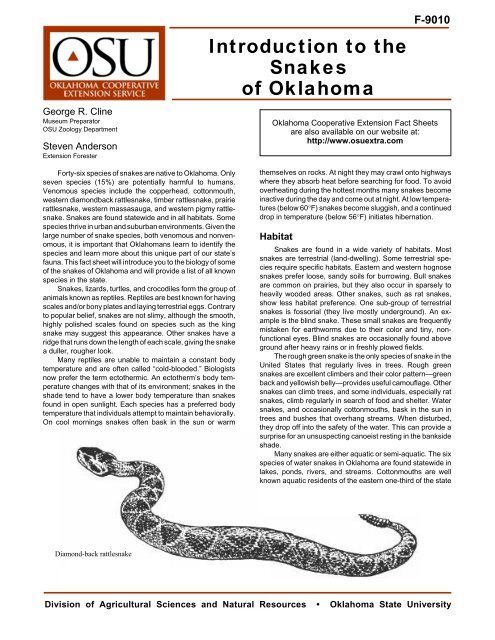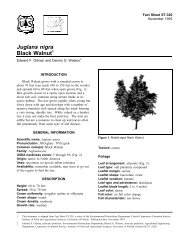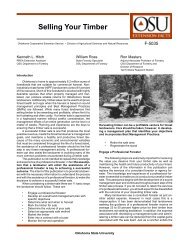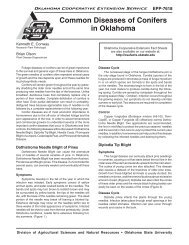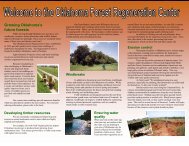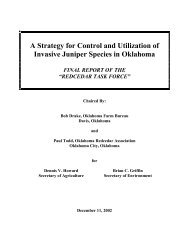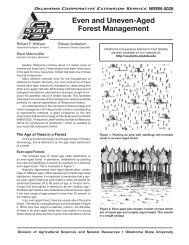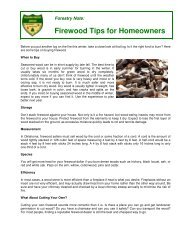Introduction to the Snakes of Oklahoma - Oklahoma Forestry Services
Introduction to the Snakes of Oklahoma - Oklahoma Forestry Services
Introduction to the Snakes of Oklahoma - Oklahoma Forestry Services
Create successful ePaper yourself
Turn your PDF publications into a flip-book with our unique Google optimized e-Paper software.
George R. Cline<br />
Museum Prepara<strong>to</strong>r<br />
OSU Zoology Department<br />
Steven Anderson<br />
Extension Forester<br />
<strong>Introduction</strong> <strong>to</strong> <strong>the</strong><br />
<strong>Snakes</strong><br />
<strong>of</strong> <strong>Oklahoma</strong><br />
F-9010<br />
<strong>Oklahoma</strong> Cooperative Extension Fact Sheets<br />
are also available on our website at:<br />
http://www.osuextra.com<br />
Forty-six species <strong>of</strong> snakes are native <strong>to</strong> <strong>Oklahoma</strong>. Only<br />
seven species (15%) are potentially harmful <strong>to</strong> humans.<br />
Venomous species include <strong>the</strong> copperhead, cot<strong>to</strong>nmouth,<br />
western diamondback rattlesnake, timber rattlesnake, prairie<br />
rattlesnake, western massasauga, and western pigmy rattlesnake.<br />
<strong>Snakes</strong> are found statewide and in all habitats. Some<br />
species thrive in urban and suburban environments. Given <strong>the</strong><br />
large number <strong>of</strong> snake species, both venomous and nonvenomous,<br />
it is important that <strong>Oklahoma</strong>ns learn <strong>to</strong> identify <strong>the</strong><br />
species and learn more about this unique part <strong>of</strong> our state’s<br />
fauna. This fact sheet will introduce you <strong>to</strong> <strong>the</strong> biology <strong>of</strong> some<br />
<strong>of</strong> <strong>the</strong> snakes <strong>of</strong> <strong>Oklahoma</strong> and will provide a list <strong>of</strong> all known<br />
species in <strong>the</strong> state.<br />
<strong>Snakes</strong>, lizards, turtles, and crocodiles form <strong>the</strong> group <strong>of</strong><br />
animals known as reptiles. Reptiles are best known for having<br />
scales and/or bony plates and laying terrestrial eggs. Contrary<br />
<strong>to</strong> popular belief, snakes are not slimy, although <strong>the</strong> smooth,<br />
highly polished scales found on species such as <strong>the</strong> king<br />
snake may suggest this appearance. O<strong>the</strong>r snakes have a<br />
ridge that runs down <strong>the</strong> length <strong>of</strong> each scale, giving <strong>the</strong> snake<br />
a duller, rougher look.<br />
Many reptiles are unable <strong>to</strong> maintain a constant body<br />
temperature and are <strong>of</strong>ten called “cold-blooded.” Biologists<br />
now prefer <strong>the</strong> term ec<strong>to</strong><strong>the</strong>rmic. An ec<strong>to</strong><strong>the</strong>rm’s body temperature<br />
changes with that <strong>of</strong> its environment; snakes in <strong>the</strong><br />
shade tend <strong>to</strong> have a lower body temperature than snakes<br />
found in open sunlight. Each species has a preferred body<br />
temperature that individuals attempt <strong>to</strong> maintain behaviorally.<br />
On cool mornings snakes <strong>of</strong>ten bask in <strong>the</strong> sun or warm<br />
<strong>the</strong>mselves on rocks. At night <strong>the</strong>y may crawl on<strong>to</strong> highways<br />
where <strong>the</strong>y absorb heat before searching for food. To avoid<br />
overheating during <strong>the</strong> hottest months many snakes become<br />
inactive during <strong>the</strong> day and come out at night. At low temperatures<br />
(below 60°F) snakes become sluggish, and a continued<br />
drop in temperature (below 56°F) initiates hibernation.<br />
Habitat<br />
<strong>Snakes</strong> are found in a wide variety <strong>of</strong> habitats. Most<br />
snakes are terrestrial (land-dwelling). Some terrestrial species<br />
require specific habitats. Eastern and western hognose<br />
snakes prefer loose, sandy soils for burrowing. Bull snakes<br />
are common on prairies, but <strong>the</strong>y also occur in sparsely <strong>to</strong><br />
heavily wooded areas. O<strong>the</strong>r snakes, such as rat snakes,<br />
show less habitat preference. One sub-group <strong>of</strong> terrestrial<br />
snakes is fossorial (<strong>the</strong>y live mostly underground). An example<br />
is <strong>the</strong> blind snake. These small snakes are frequently<br />
mistaken for earthworms due <strong>to</strong> <strong>the</strong>ir color and tiny, nonfunctional<br />
eyes. Blind snakes are occasionally found above<br />
ground after heavy rains or in freshly plowed fields.<br />
The rough green snake is <strong>the</strong> only species <strong>of</strong> snake in <strong>the</strong><br />
United States that regularly lives in trees. Rough green<br />
snakes are excellent climbers and <strong>the</strong>ir color pattern—green<br />
back and yellowish belly—provides useful camouflage. O<strong>the</strong>r<br />
snakes can climb trees, and some individuals, especially rat<br />
snakes, climb regularly in search <strong>of</strong> food and shelter. Water<br />
snakes, and occasionally cot<strong>to</strong>nmouths, bask in <strong>the</strong> sun in<br />
trees and bushes that overhang streams. When disturbed,<br />
<strong>the</strong>y drop <strong>of</strong>f in<strong>to</strong> <strong>the</strong> safety <strong>of</strong> <strong>the</strong> water. This can provide a<br />
surprise for an unsuspecting canoeist resting in <strong>the</strong> bankside<br />
shade.<br />
Many snakes are ei<strong>the</strong>r aquatic or semi-aquatic. The six<br />
species <strong>of</strong> water snakes in <strong>Oklahoma</strong> are found statewide in<br />
lakes, ponds, rivers, and streams. Cot<strong>to</strong>nmouths are well<br />
known aquatic residents <strong>of</strong> <strong>the</strong> eastern one-third <strong>of</strong> <strong>the</strong> state<br />
Diamond-back rattlesnake<br />
Division <strong>of</strong> Agricultural Sciences and Natural Resources • <strong>Oklahoma</strong> State University
and those counties along <strong>the</strong> sou<strong>the</strong>rn boundary, west <strong>to</strong><br />
Comanche county. Few people realize that copperheads can<br />
also be aquatic. While garter snakes are considered <strong>to</strong> be<br />
terrestrial, <strong>the</strong>y frequently enter <strong>the</strong> water <strong>to</strong> feed on minnows<br />
and amphibians. In western <strong>Oklahoma</strong>, certain species <strong>of</strong><br />
garter snakes are found only near some permanent water<br />
source. Possibly <strong>the</strong> most interesting aquatic snake is <strong>the</strong><br />
mud snake, found in swampy areas in sou<strong>the</strong>astern <strong>Oklahoma</strong>.<br />
Mud snakes <strong>of</strong>ten lie loosely coiled under rocks and<br />
fallen trees. This habit may well have given rise <strong>to</strong> <strong>the</strong> fable <strong>of</strong><br />
<strong>the</strong> “hoop snake,” <strong>the</strong> snake that bites its tail and rolls around<br />
like a hoop. Mud snakes are also responsible for <strong>the</strong> fabled<br />
“stinging snake myth.” With jabs <strong>of</strong> <strong>the</strong> horny-tipped tail, mud<br />
snakes maneuver large prey such as aquatic salamanders<br />
in<strong>to</strong> position for eating. The mud snake uses this horny tip in<br />
<strong>the</strong> same way <strong>to</strong> startle intruders.<br />
Poisonous snakes are found throughout <strong>the</strong> state. Cot<strong>to</strong>nmouths,<br />
copperheads, massasaugas, and pigmy rattlesnakes<br />
are usually found in moist environments. Prairie<br />
rattlesnakes are found in <strong>the</strong> prairies <strong>of</strong> western <strong>Oklahoma</strong>,<br />
while timber rattlesnakes inhabit <strong>the</strong> forested eastern half <strong>of</strong><br />
<strong>the</strong> state. Western diamondback rattlesnakes are most common<br />
in sou<strong>the</strong>rn and western <strong>Oklahoma</strong>, but <strong>the</strong>ir range<br />
extends as far north as Tulsa, Cherokee, and Adair Counties.<br />
Rocky outcrops providing shelter, basking, and possible<br />
hibernation sites are a favorite habitat for copperheads and<br />
rattlesnakes. Where rocky outcrops are scarce, many different<br />
species <strong>of</strong> snakes <strong>of</strong>ten share dens for hibernating.<br />
The local dump is one habitat not <strong>of</strong>ten considered.<br />
Exposed trash and litter provide refuge for bottle snakes and<br />
<strong>the</strong> small animals that snakes use as food. Snake populations<br />
can be controlled around homes by simply removing tall<br />
weeds, brush, rubbish, etc., that provide potential cover. In an<br />
effort <strong>to</strong> attract snakes for study, biologists will <strong>of</strong>ten “seed” an<br />
area with large plywood or tin pieces, thus providing <strong>the</strong> cover<br />
essential <strong>to</strong> snake survival.<br />
Food Habits<br />
All snakes are carnivorous. Most small species <strong>of</strong> snakes<br />
eat invertebrates. Ringneck snakes, brown snakes, worm<br />
snakes, and o<strong>the</strong>rs prefer earthworms, beetles, and insect<br />
larvae. Rotting stumps with termite colonies are a favorite<br />
dining place for central lined snakes. Rough green snakes<br />
consume grasshoppers, moths, and caterpillars.<br />
Fish, amphibians, and aquatic invertebrates make up <strong>the</strong><br />
diet <strong>of</strong> most water snakes. An exception <strong>to</strong> this rule, Graham’s<br />
water snake consumes large numbers <strong>of</strong> crayfish. A common<br />
question is, can a cot<strong>to</strong>nmouth bite underwater Since a<br />
cot<strong>to</strong>nmouth’s diet consists mainly <strong>of</strong> fish and amphibians, <strong>the</strong><br />
answer is a resounding yes! Hognose snakes eat <strong>to</strong>ads, frogs,<br />
and lizards, and this may be a clue regarding <strong>the</strong> recent<br />
decline in hognose numbers. Increased pesticide use may<br />
adversely affect <strong>the</strong> hog nose’s main food sources, <strong>to</strong>ads, or<br />
may have directly or indirectly reduced <strong>the</strong> hognose population.<br />
Small mammals and birds make up <strong>the</strong> diet <strong>of</strong> most larger<br />
snakes. Rat snakes, bullsnakes, racers, coachwhips, and<br />
rattlesnakes eat birds and small mammals in varying degrees.<br />
Adult diet may be influenced by individual experience; a snake<br />
that learns, as a juvenile, <strong>to</strong> eat small mammals or birds <strong>of</strong>ten<br />
continues <strong>to</strong> do so throughout life.<br />
Many snakes, including whip snakes; racers; cot<strong>to</strong>nmouths;<br />
garter snakes; and kingsnakes, eat snakes. Of <strong>the</strong>se<br />
snake eaters, kingsnakes are <strong>the</strong> most no<strong>to</strong>rious. Kingsnakes<br />
are especially interesting because <strong>the</strong>y are relatively <strong>to</strong>lerant<br />
(immune) <strong>to</strong> <strong>the</strong> venom <strong>of</strong> our native poisonous snakes.<br />
Rattlesnakes recognize kingsnakes and make no effort <strong>to</strong> bite<br />
<strong>the</strong>m. Instead, <strong>the</strong>y attempt <strong>to</strong> repel hungry kingsnakes by<br />
“throwing” loops <strong>of</strong> <strong>the</strong>ir bodies at <strong>the</strong>m. Kingsnakes cannot<br />
be depended upon <strong>to</strong> eliminate <strong>the</strong> poisonous snakes from a<br />
given area. They nei<strong>the</strong>r selectively eat rattlesnakes nor do<br />
<strong>the</strong>y eat large numbers <strong>of</strong> o<strong>the</strong>r snakes. However, kingsnakes,<br />
like many o<strong>the</strong>r snakes, may be helpful around a home.<br />
<strong>Snakes</strong> have a highly developed sense <strong>of</strong> smell that is<br />
associated with <strong>the</strong> <strong>to</strong>ngue. The tips <strong>of</strong> <strong>the</strong> <strong>to</strong>ngue capture<br />
odor chemicals in <strong>the</strong> air and transfer <strong>the</strong>m <strong>to</strong> <strong>the</strong> paired<br />
Jacobson’s organs that lie in <strong>the</strong> ro<strong>of</strong> <strong>of</strong> <strong>the</strong> mouth. These<br />
organs are very sensitive <strong>to</strong> odors and help snakes recognize<br />
potential food. Eyes <strong>of</strong> snakes are sensitive <strong>to</strong> movement. The<br />
pit vipers (rattlesnakes, cot<strong>to</strong>nmouths, and copperheads)<br />
have an added feature for detecting prey. Between <strong>the</strong> eye<br />
and <strong>the</strong> nose is a depression, <strong>the</strong> facial pit, which is a heat<br />
sensor. This organ enables a pit viper <strong>to</strong> detect and strike a<br />
nearby warm object with great accuracy, even in <strong>the</strong> dark.<br />
Imagine how useful this system would be for a snake searching<br />
for ground squirrels in a burrow. With <strong>the</strong> use <strong>of</strong> both eyes<br />
and facial pits, pit vipers can differentiate between a warm<br />
moving object, such as a squirrel, a cold moving object, such<br />
as a leaf, or a hot stationary object, such as a rock.<br />
Once <strong>the</strong> prey is detected it must be captured and<br />
subdued. Prey is captured and held by several rows <strong>of</strong> sharp<br />
teeth that curve <strong>to</strong>ward <strong>the</strong> back <strong>of</strong> <strong>the</strong> mouth. Nonvenomous<br />
snakes subdue prey by constriction or suffocation. Kingsnakes<br />
and rat snakes loop <strong>the</strong>mselves around <strong>the</strong>ir prey and squeeze.<br />
Prey is killed by suffocation or by creating so much pressure<br />
that <strong>the</strong> heart s<strong>to</strong>ps beating. Prey is not crushed, as it is<br />
popularly believed. Racers and bullsnakes kill prey by pushing<br />
against rocks, walls, or <strong>the</strong> ground. Ano<strong>the</strong>r method <strong>of</strong><br />
killing prey is by <strong>the</strong> use <strong>of</strong> venoms. Venoms produced by <strong>the</strong><br />
pit vipers serve <strong>to</strong> kill prey, as well as aid in <strong>the</strong> digestion <strong>of</strong><br />
prey. As much as an hour may be required for a pit viper <strong>to</strong> find<br />
its prey after <strong>the</strong> initial bite. During this time <strong>the</strong> venom breaks<br />
down tissue, incidentally preparing it for digestion. <strong>Snakes</strong> do<br />
not normally eat when temperatures are not conducive <strong>to</strong><br />
rapid digestion.<br />
<strong>Snakes</strong> have several features that enable <strong>the</strong>m <strong>to</strong> swallow<br />
food that is larger than <strong>the</strong>ir bodies. The best-known<br />
feature is a lower jaw that is composed <strong>of</strong> two bones that are<br />
connected by a ligament. This ligament allows <strong>the</strong> jaws <strong>to</strong><br />
stretch apart and also enables both sides <strong>of</strong> <strong>the</strong> jaw <strong>to</strong> be<br />
moved independently <strong>of</strong> <strong>the</strong> o<strong>the</strong>r. Unlike <strong>the</strong> skulls <strong>of</strong> mammals,<br />
snakes skulls are made up <strong>of</strong> bones that are held<br />
<strong>to</strong>ge<strong>the</strong>r by ligaments. Muscles are arranged so that individual<br />
bones <strong>of</strong> <strong>the</strong> skull can move independently. Thus, a<br />
snake can lift <strong>the</strong> bone containing <strong>the</strong> teeth <strong>of</strong> <strong>the</strong> upper left<br />
side <strong>of</strong> <strong>the</strong> head, move this bone forward and imbed <strong>the</strong> teeth<br />
in <strong>the</strong> prey, and draw <strong>the</strong> prey in<strong>to</strong> <strong>the</strong> mouth by contracting<br />
<strong>the</strong> muscles that return <strong>the</strong> bone <strong>to</strong> its original position.<br />
Coordinated movements <strong>of</strong> <strong>the</strong> upper and lower jaws move<br />
prey in<strong>to</strong> <strong>the</strong> mouth in a process that looks like <strong>the</strong> snake is<br />
crawling around its prey. Additional features include a throat<br />
that is highly elastic <strong>to</strong> allow passage <strong>of</strong> large food items and<br />
9010-2
a special “tube” that can be extended from <strong>the</strong> mouth <strong>to</strong><br />
provide air when <strong>the</strong> mouth is filled with large prey.<br />
Reproduction<br />
There are three ways in which vertebrates can produce<br />
<strong>of</strong>fspring: oviparity (egg laying), ovoviviparity (egg retention),<br />
and viviparity (placental, similar <strong>to</strong> man and o<strong>the</strong>r mammals).<br />
All three methods are found in <strong>Oklahoma</strong> snakes. Egg laying<br />
is probably <strong>the</strong> most common form <strong>of</strong> reproduction in snakes.<br />
Egg layers include bullsnakes, rat snakes, kingsnakes, racers,<br />
coachwhips, and ringneck snakes, <strong>to</strong> name a few. Reptilian<br />
eggs are covered by a <strong>to</strong>ugh, lea<strong>the</strong>ry shell that is<br />
permeable <strong>to</strong> water. Nest site selection is very important since<br />
<strong>to</strong>o much or <strong>to</strong>o little moisture can result in loss <strong>of</strong> <strong>the</strong> clutch.<br />
Egg retention is ano<strong>the</strong>r form <strong>of</strong> reproduction that is fairly<br />
common. <strong>Snakes</strong> using this method produce a thin, transparent<br />
membrane that surrounds <strong>the</strong> embryo. These “eggs” are<br />
retained within <strong>the</strong> female’s body until hatching. Young may<br />
hatch while <strong>the</strong> eggs are still in <strong>the</strong> female or immediately after<br />
<strong>the</strong> eggs have been “laid.” Young produced in this manner<br />
probably have a better chance <strong>of</strong> surviving since <strong>the</strong> female<br />
can help regulate <strong>the</strong> temperature and moisture content <strong>of</strong> <strong>the</strong><br />
developing eggs. Water snakes, cot<strong>to</strong>nmouths, copperheads,<br />
and all rattlesnakes are ovoviviparous.<br />
The last mode <strong>of</strong> reproduction, viviparity, surprises most<br />
people. Viviparous animals have placentas that provide a<br />
means for <strong>the</strong> mo<strong>the</strong>r <strong>to</strong> get nourishment <strong>to</strong> <strong>the</strong> developing<br />
embryo. This is a very effective method for bearing young that<br />
might o<strong>the</strong>rwise have low hatching success. Central lined<br />
snakes, brown snakes, and garter snakes are all viviparous.<br />
S<strong>to</strong>ries <strong>of</strong> females swallowing <strong>the</strong>ir young when threatened<br />
and regurgitating <strong>the</strong>m later may have originated when people<br />
saw a recently dead viviparous or ovoviviparous female give<br />
“birth” <strong>to</strong> her young.<br />
The number <strong>of</strong> young produced by a female is a function<br />
<strong>of</strong> <strong>the</strong> age and size <strong>of</strong> <strong>the</strong> female, reproductive experience,<br />
and general health. Larger females usually, but not always,<br />
produce larger clutches than smaller females. Clutch size in<br />
ringneck snakes varies between 1 and 10 eggs per clutch with<br />
an average <strong>of</strong> 5 eggs per clutch. Black rat snakes lay clutches<br />
ranging from 5 <strong>to</strong> 44 eggs per clutch with an average <strong>of</strong> 12<br />
eggs per clutch.<br />
Brown snakes (9 <strong>to</strong> 13 inches long) average 14 eggs per<br />
clutch, while kingsnakes (36 <strong>to</strong> 48 inches long) average only<br />
10.1 eggs per clutch. Carter snakes average 12 young per<br />
litter, but individuals have given birth <strong>to</strong> up <strong>to</strong> 85 young.<br />
Copperheads and cot<strong>to</strong>nmouths produce an average <strong>of</strong> 5<br />
young per litter. The large rattlesnakes produce an average <strong>of</strong><br />
10 <strong>to</strong> 11 young per litter.<br />
<strong>Snakes</strong> mate in <strong>the</strong> spring shortly after <strong>the</strong>y emerge from<br />
hibernation. Females <strong>of</strong> some species produce a chemical<br />
odor, a pheromone, that attracts males. Pair bonding between<br />
snakes is rare, and maternal care is short-lived if present at all.<br />
A few species <strong>of</strong> snakes are capable <strong>of</strong> producing two<br />
clutches each year, but <strong>the</strong>se individuals are exceptional.<br />
Reproduction varies greatly in rattlesnakes. Prairie rattlesnakes<br />
appear <strong>to</strong> reproduce only every o<strong>the</strong>r year. Reproduction<br />
in o<strong>the</strong>r rattlesnakes probably depends on available<br />
resources. If resources are available, <strong>the</strong>y may reproduce<br />
every year. If resources are limited, <strong>the</strong>y may skip reproduction.<br />
Removal <strong>of</strong> females, especially large females from<br />
populations that are not producing every year, might have a<br />
serious effect on <strong>the</strong> local population.<br />
Snake Bites, Venom, and Poisonous<br />
<strong>Snakes</strong><br />
The best cure for snakebite is <strong>to</strong> avoid being bitten.<br />
Considerable controversy exists over <strong>the</strong> “proper” method for<br />
treating snakebite, so it is a situation that is best avoided. The<br />
best way <strong>to</strong> avoid snakebite is <strong>to</strong> learn more about <strong>the</strong><br />
venomous snakes in your area, where <strong>the</strong>y can be found, what<br />
<strong>the</strong>y like, etc. There are several field guides and an excellent<br />
state book on reptiles that will help you identify venomous<br />
snakes and <strong>the</strong>ir habitats. Take proper precautions when<br />
traveling in “snake country.” Avoid placing your hands or feet<br />
blindly. Proper clothing can fur<strong>the</strong>r reduce <strong>the</strong> risk <strong>of</strong> snakebite.<br />
Lea<strong>the</strong>r high-<strong>to</strong>pped boots are sufficient <strong>to</strong> s<strong>to</strong>p <strong>the</strong> fangs<br />
<strong>of</strong> most poisonous snakes. Heavy canvas pants and protective<br />
leggings can provide added protection in high-risk areas.<br />
Finally, do not wander outside at night without a light or<br />
protective covering for legs and feet.<br />
One last precaution is <strong>to</strong> learn <strong>to</strong> identify <strong>the</strong> poisonous<br />
snakes in your area. A surprising number <strong>of</strong> people are bitten<br />
each year because <strong>the</strong>y picked up a snake <strong>the</strong>y thought was<br />
not poisonous. When in doubt, do not take a chance: Do not<br />
pick up any snake that you can not identify. There are four<br />
features that can be used <strong>to</strong> identify poisonous snakes.<br />
Presence <strong>of</strong> rattles on <strong>the</strong> tail positively identifies a snake as<br />
being poisonous. Be certain that <strong>the</strong> rattles are seen, snakes<br />
will vibrate <strong>the</strong>ir tails when <strong>the</strong>y are nervous or frightened and<br />
contact <strong>of</strong> <strong>the</strong> tail with dried leaves or grass produces a sound<br />
that can be mistaken for a rattle. Lack <strong>of</strong> a rattle does not<br />
exclude <strong>the</strong> possibility that a snake is poisonous.<br />
Head shape can help <strong>to</strong> identify poisonous snakes.<br />
Poisonous snakes in North American tend <strong>to</strong> have diamond or<br />
triangular-shaped heads (See Figure 1). Harmless snakes<br />
have narrow heads. This characteristic is not always identifiable<br />
since snakes flatten <strong>the</strong>ir heads when threatened <strong>to</strong><br />
make <strong>the</strong>mselves look bigger. Thus, nonpoisonous snakes<br />
could be mistaken for poisonous ones.<br />
Vertical eye pupils, “cat’s eyes,” are a strong sign that a<br />
snake might be poisonous. A few harmless snakes have<br />
vertical eye pupils and may be mistaken as venomous on this<br />
basis. Vertical eye pupils are <strong>of</strong>ten hard <strong>to</strong> see in dim light or<br />
shade.<br />
The best identifying character is <strong>the</strong> facial pit. This is a<br />
depression on <strong>the</strong> side <strong>of</strong> <strong>the</strong> face just below a line between<br />
<strong>the</strong> eyes and <strong>the</strong> nostrils (See Figure 1). This pit can be seen<br />
from a safe distance if you know what <strong>to</strong> look for. The<br />
venomous snakes in <strong>Oklahoma</strong> have facial pits. Looking for a<br />
combination <strong>of</strong> <strong>the</strong>se characters will usually help you identify<br />
a snake properly.<br />
If you have a dead snake, it can be identified by examining<br />
<strong>the</strong> scales under <strong>the</strong> tail. The tail is that portion <strong>of</strong> <strong>the</strong> snake<br />
that extends past <strong>the</strong> vent (anus). Poisonous snakes have a<br />
single row <strong>of</strong> scales immediately beyond <strong>the</strong> vent, while nonpoisonous<br />
snakes usually have 2 rows <strong>of</strong> scales beyond <strong>the</strong><br />
vent (See Figure 1). Viewing snakes at local zoos and purchasing<br />
a good field guide will fur<strong>the</strong>r sharpen your identification<br />
skills.<br />
Regardless <strong>of</strong> precautions, people still get bitten by<br />
poisonous snakes. If bitten, <strong>the</strong> most important thing <strong>to</strong><br />
9010-3
emember is <strong>to</strong> remain calm. Snakebites are not usually fatal.<br />
Currently, 6,000 <strong>to</strong> 7,000 people are bitten each year, with an<br />
average death rate <strong>of</strong> 15 people per year. This is less than <strong>the</strong><br />
number <strong>of</strong> people that die each year from bee stings or<br />
lightning, and it is less than <strong>the</strong> number <strong>of</strong> people that die each<br />
day in au<strong>to</strong>mobile accidents.<br />
There are two general forms <strong>of</strong> snake venoms: neuro<strong>to</strong>xins<br />
and hemo<strong>to</strong>xins. Neuro<strong>to</strong>xins are fairly fast acting and can<br />
cause death by paralysis. Hemo<strong>to</strong>xins are slower acting<br />
<strong>to</strong>xins and can cause death by hemorrhaging. No venom is<br />
entirely neuro<strong>to</strong>xic or hemo<strong>to</strong>xic; cobras, mambas, and coral<br />
snakes produce mostly neuro<strong>to</strong>xins, while <strong>the</strong> pit vipers<br />
produce mostly hemo<strong>to</strong>xins. Both types <strong>of</strong> venoms can be<br />
very potent, but neuro<strong>to</strong>xins are generally considered <strong>to</strong> be<br />
more dangerous.<br />
There is a little agreement (even among medical personnel)<br />
regarding <strong>the</strong> proper method <strong>of</strong> snakebite treatment.<br />
Treatments range from doing absolutely nothing <strong>to</strong> removing<br />
blood vessels and tissues from <strong>the</strong> afflicted area. A few things<br />
are agreed upon, however. First, <strong>the</strong> victim must remain calm.<br />
Caffeine, cigarettes, or alcohol should not be administered. It<br />
is important <strong>to</strong> get <strong>to</strong> a hospital as quickly as possible. In most<br />
cases doc<strong>to</strong>rs can administer an anti<strong>to</strong>xin that will help reduce<br />
damage caused by <strong>the</strong> bite. Antivenom kits can be purchased<br />
through local physicians, but <strong>the</strong> kits are expensive, may not<br />
keep indefinitely, should be administered by trained personnel,<br />
and can be dangerous if not deadly. Modern snakebite<br />
kits are available at sporting goods or outdoor equipment<br />
s<strong>to</strong>res. These kits should be used by trained people. Seek<br />
advice and instructions from your physician before going in<strong>to</strong><br />
snake country. In summary, <strong>the</strong> best thing <strong>to</strong> do in <strong>the</strong> event<br />
<strong>of</strong> a poisonous snakebite is <strong>to</strong> remain calm and get <strong>to</strong> a<br />
hospital as quickly as possible.<br />
Before concluding this section, it may be worthwhile <strong>to</strong><br />
mention <strong>the</strong> coral snake. The eastern coral snake is a<br />
medium-sized species that is related <strong>to</strong> <strong>the</strong> old-world cobras,<br />
mambas, etc. Coral snakes are found across <strong>the</strong> Red River<br />
in Texas and individuals may be carried in<strong>to</strong> <strong>Oklahoma</strong> by<br />
floods, but no au<strong>the</strong>ntic record <strong>of</strong> a coral snake has ever been<br />
reported in <strong>Oklahoma</strong>. The problem with coral snakes is that<br />
<strong>the</strong>y are different from pit vipers; coral snakes have rounded<br />
heads, circular eye pupils, and lack facial pits. Identification is<br />
based on <strong>the</strong> color pattern. Coral snakes have red, yellow,<br />
and black rings that encircle <strong>the</strong> body. Two harmless species,<br />
<strong>the</strong> milksnake and <strong>the</strong> scarlet snake, are also red, yellow and<br />
black, but <strong>the</strong>ir bodies do not have encircling bands. These<br />
snakes also differ in <strong>the</strong> pattern that <strong>the</strong> colors have. The best<br />
way <strong>to</strong> remember <strong>the</strong> color patterns is by thinking <strong>of</strong> <strong>the</strong><br />
following rhymes:<br />
If red <strong>to</strong>uches yellow, will harm a fellow<br />
If red <strong>to</strong>uches black, it’s a friend <strong>of</strong> Jack.<br />
Or<br />
Red and yellow, kill a fellow<br />
Red and black, venom lack.<br />
Figure 1. Snake Identification<br />
Poisonous <strong>Snakes</strong><br />
Coral Snake<br />
Non-Poisonous <strong>Snakes</strong><br />
Scarlet Snake<br />
red black red black<br />
yellow<br />
O<strong>the</strong>r than markings, resembles non-poisonous snakes.<br />
red<br />
black<br />
Pit Vipers<br />
Flat triangular head<br />
Usually oval elongated head<br />
O<strong>the</strong>r <strong>Snakes</strong><br />
Eye<br />
Nostril<br />
Pit<br />
Eye<br />
Nostril<br />
Underside <strong>of</strong> tail (*)<br />
Facial pit; vertical pupil<br />
Single row <strong>of</strong> scales;<br />
single anal plate<br />
(*) execpt for long-nosed snakes in OKlahoma<br />
No pit; round pupil<br />
Underside <strong>of</strong> tail<br />
Double row <strong>of</strong> scales;<br />
divided anal plate<br />
9010-4
<strong>Snakes</strong> and Man<br />
Man has more impact on <strong>the</strong> life <strong>of</strong> snakes than viceversa.<br />
Every day man destroys precious habitat and pollutes<br />
streams. Pesticides reduce <strong>the</strong> amount <strong>of</strong> food available <strong>to</strong><br />
some species. Increasing pesticide levels are accumulating in<br />
<strong>the</strong> tissues and organs <strong>of</strong> snakes, possibly affecting <strong>the</strong>ir<br />
growth and reproduction.<br />
The impact <strong>of</strong> snakes upon man is both positive and<br />
negative. <strong>Snakes</strong> are capable <strong>of</strong> consuming large numbers <strong>of</strong><br />
rodent pests, many <strong>of</strong> which are carriers <strong>of</strong> disease and<br />
parasites that adversely affect lives<strong>to</strong>ck and human populations.<br />
One study <strong>of</strong> bullsnakes found that a single 2.5-pound<br />
bullsnake could consume 6.7 pounds <strong>of</strong> food in a six-month<br />
period. This approximately equals <strong>the</strong> weight <strong>of</strong> twelve pocket<br />
gophers. In ano<strong>the</strong>r food study <strong>of</strong> bullsnakes, one individual<br />
was found <strong>to</strong> have eaten 35 mice at one sitting. Considering<br />
<strong>the</strong> amount <strong>of</strong> damage that a single mouse can cause <strong>to</strong> crops,<br />
grain, and food, a bullsnake is a very valuable ally. <strong>Snakes</strong> are<br />
also making news on <strong>the</strong> medical front. Currently, much time<br />
and effort is being given <strong>to</strong> <strong>the</strong> research <strong>of</strong> venoms in association<br />
with a number <strong>of</strong> diseases.<br />
Unfortunately for snakes, man tends <strong>to</strong> accentuate <strong>the</strong><br />
negative. Damages <strong>to</strong> lives<strong>to</strong>ck caused by snakes are minimal<br />
compared <strong>to</strong> o<strong>the</strong>r sources <strong>of</strong> injury. While a single snake<br />
can inflict a lot <strong>of</strong> damage <strong>to</strong> chickens, capture, and removal<br />
<strong>of</strong> <strong>the</strong>se individuals will <strong>of</strong>ten solve <strong>the</strong> problem. Persecution<br />
<strong>of</strong> all snakes may have Biblical origins, but is perpetuated by<br />
ignorance and <strong>the</strong> needlessly exaggerated fear <strong>of</strong> death from<br />
snakebite.<br />
<strong>Snakes</strong> and religion are a very curious combination.<br />
While snakes are loa<strong>the</strong>d by some religions, <strong>the</strong>y are revered<br />
in o<strong>the</strong>rs. Ancient Egyptians had a snake god and kept cobras<br />
as pets in <strong>the</strong>ir homes. In <strong>the</strong> United States, snakes are used<br />
by <strong>the</strong> Hopi Indians in many religious ceremonies. In West<br />
Virginia, church members regularly handle venomous snakes<br />
as a symbol <strong>of</strong> <strong>the</strong>ir faith in God. The average attitude falls<br />
somewhere between loathing and worshipping snakes. As<br />
more is learned about snakes, many people find <strong>the</strong>ir fear<br />
replaced by fascination.<br />
As stated before, snakes can be intimately associated<br />
with man, and some species actually thrive around homes.<br />
For those individuals who fear or dislike snakes, <strong>the</strong>re is an<br />
ongoing battle <strong>to</strong> kill snakes. This may temporarily reduce <strong>the</strong><br />
number <strong>of</strong> snakes, but it can never eliminate <strong>the</strong>m. As long as<br />
food and habitat are available, <strong>the</strong>re will always be snakes. By<br />
altering habitat, a more permanent reduction in numbers <strong>of</strong><br />
snakes can be achieved. Disposal <strong>of</strong> brush piles and scattered<br />
refuse will remove cover for small mammals and snakes.<br />
Placing feed and grain in rodent-pro<strong>of</strong> containers will reduce<br />
rodent numbers and <strong>the</strong>reby reduce snake numbers. There<br />
are no known snake repellents, although one company makes<br />
a “trap” using pine tar. <strong>Snakes</strong> can be kept out <strong>of</strong> houses by<br />
sealing cracks in foundations, around windows, air conditioners,<br />
and doors. Following <strong>the</strong>se few simple suggestions will<br />
help reduce <strong>the</strong> number <strong>of</strong> unwanted snakes around your<br />
home.<br />
Note: We have attempted <strong>to</strong> use <strong>the</strong> common names<br />
suggested by Collins et. al., Standard Common and Current<br />
Scientific Names for North American Amphibians<br />
and Reptiles, SSAR Herp publication No. 12., 1982.<br />
Many common names are used. A given snake may<br />
be called by a variety <strong>of</strong> names in different states or <strong>of</strong>ten<br />
in different parts <strong>of</strong> <strong>the</strong> same state. The common use <strong>of</strong><br />
“moccasin” for any snake found near water has led <strong>to</strong> <strong>the</strong><br />
needless death <strong>of</strong> many non-poisonous snakes.<br />
Fur<strong>the</strong>r Information<br />
The following books can be obtained from most book<br />
s<strong>to</strong>res or may be borrowed from your local library.<br />
Behler, John L. and L. Wayne King. The Audubon Society<br />
Field Guide <strong>to</strong> North American Amphibians and Reptiles<br />
Alfred A. Knopf, New York. 719 pgs. 1979. Includes color<br />
pho<strong>to</strong>graphs <strong>of</strong> all <strong>the</strong> amphibians and reptiles <strong>of</strong> North<br />
America and brief description <strong>of</strong> distribution and habitats.<br />
Conan, Roger, A Field Guide <strong>to</strong> Reptiles and Amphibians <strong>of</strong><br />
Eastern and Central North America. Hough<strong>to</strong>n Mifflin<br />
Co., Bos<strong>to</strong>n. 429 pgs. 1975. Includes line drawings and<br />
color paintings <strong>of</strong> most amphibians and reptiles east <strong>of</strong><br />
<strong>the</strong> 100th meridian with brief description <strong>of</strong> <strong>the</strong>ir distribution<br />
and habitats.<br />
Fitch, Henry. Reproductive Cycles in Lizards and <strong>Snakes</strong>.<br />
Museum <strong>of</strong> Natural His<strong>to</strong>ry, Univ. <strong>of</strong> Kansas Misc. Public<br />
No. 52:1-247. 1970. Reviews and reports clutch size,<br />
clutch frequency, and reproductive behavior <strong>of</strong> lizards<br />
and snakes from throughout <strong>the</strong> world.<br />
Smith, Hobart M. and Edward D. Brodie, Jr. A Guide <strong>to</strong> Field<br />
Identification-Reptiles <strong>of</strong> North America. Golden Press,<br />
New York, NY 240 pgs. 1982. Color plates <strong>of</strong> all North<br />
American reptiles with easy <strong>to</strong> use identification keys.<br />
Webb, Robert G. Reptiles <strong>of</strong> <strong>Oklahoma</strong>. University <strong>of</strong> <strong>Oklahoma</strong><br />
Press, Norman, OK 370 pgs. 1975.;. Excellent spot<br />
distribution maps and keys <strong>to</strong> <strong>the</strong> identification <strong>of</strong> all<br />
native <strong>Oklahoma</strong> reptiles but lacks drawings or pho<strong>to</strong>s <strong>of</strong><br />
<strong>the</strong> species.<br />
O<strong>the</strong>r Sources<br />
Additional information can be obtained by contacting <strong>the</strong><br />
reptile cura<strong>to</strong>r at <strong>Oklahoma</strong> City Zoo or Tulsa Zoo or by<br />
contacting <strong>the</strong> biology department at your local college or<br />
university.<br />
9010-5
A Checklist <strong>of</strong> <strong>Oklahoma</strong> <strong>Snakes</strong><br />
Harmless snakes<br />
Arizona elegans—glossy snake<br />
Carphophis amaenus—worm snake<br />
Cemophora coccinea—scarlet snake<br />
Coluber cons<strong>to</strong>c<strong>to</strong>r—racer<br />
Diadophis punctatus—ring-neck snake<br />
Elaphe guttata—great plains rat snake<br />
E. obsoleta—black rat snake<br />
Farancia abacura—mud snake<br />
Heterodon nasicus—western hognose snake<br />
H. platyrhinos—eastern hognose snake<br />
Hypsiglena <strong>to</strong>rquata—Texas night snake<br />
Lampropeltis calligaster—prairie kingsnake<br />
L. getulus—speckled and desert kingsnakes<br />
L. triangulum—milk snake<br />
Lep<strong>to</strong>typhlops dulcis—blind snake<br />
Masticophis flagellum—coachwhip snake<br />
Nerodia erythrogaster—yellow-bellied and blotched water<br />
snake<br />
N. fasciata—broad-banded water snake<br />
N. rhombifera—diamond-back water snake<br />
N. sipedon—nor<strong>the</strong>rn and midland water snake<br />
Opheodrys aestivus—keeled green snake<br />
Pituophis melanoleucus—bullsnake<br />
Regina grahami—Graham’s water snake<br />
P. rigida—glossy water snake<br />
Rhinocheilus lecontei—long-nosed snake<br />
Sonora semiannulata—great plains ground snake<br />
S<strong>to</strong>reria dekayi—brown snake<br />
S. occipi<strong>to</strong>maculata—red bellied snake<br />
Tantilla gracilis—flat-headed snake<br />
T. nigriceps—black-headed snake<br />
Thamnophis cyr<strong>to</strong>psis—black-necked garter snake<br />
T. elegans—wandering garter snake<br />
T. marcianus—checkered garter snake<br />
T. proximus—western ribbon snake<br />
T. radix—plains garter snake<br />
T. sirtalis—red-sided and Texas garter snakes<br />
Tropidoclonion lineatum—lined snake<br />
Virginia striatula—rough earth snake<br />
V. valeriae—smooth earth snake<br />
Poisonous snakes<br />
Agkistrodon con<strong>to</strong>rtrix—copperhead<br />
A. piscivorous—cot<strong>to</strong>nmouth or water moccasin<br />
Crotalus atrox—western diamond-back rattlesnake<br />
C. horridus—timber rattlesnake<br />
C. viridis—prairie rattlesnake<br />
Sistrurus catenatus—western massasauga rattlesnake<br />
S. miliarius—western pigmy rattlesnake<br />
Acknowledgements:<br />
This material was reviewed by Dr. Jeff Black, Biology<br />
Department, <strong>Oklahoma</strong> Baptist State University; Alice Echelle,<br />
Research Associate, OSU Zoology Department, Bob Jenni,<br />
Naturalist and Lecturer, Edmond, and biologists from <strong>the</strong><br />
Game Division, <strong>Oklahoma</strong> Department <strong>of</strong> Wildlife. Authors <strong>of</strong><br />
<strong>the</strong> original Fact Sheet were Bill Altman and George Cline.<br />
Timber rattlesnake<br />
Copperhead<br />
Massasauga<br />
9010-6
The <strong>Oklahoma</strong> Cooperative Extension Service<br />
Bringing <strong>the</strong> University <strong>to</strong> You!<br />
The Cooperative Extension Service is <strong>the</strong> largest,<br />
most successful informal educational organization in<br />
<strong>the</strong> world. It is a nationwide system funded and<br />
guided by a partnership <strong>of</strong> federal, state, and local<br />
governments that delivers information <strong>to</strong> help people<br />
help <strong>the</strong>mselves through <strong>the</strong> land-grant university<br />
system.<br />
Extension carries out programs in <strong>the</strong> broad categories<br />
<strong>of</strong> agriculture, natural resources and environment;<br />
family and consumer sciences; 4-H and o<strong>the</strong>r<br />
youth; and community resource development. Extension<br />
staff members live and work among <strong>the</strong><br />
people <strong>the</strong>y serve <strong>to</strong> help stimulate and educate<br />
Americans <strong>to</strong> plan ahead and cope with <strong>the</strong>ir problems.<br />
Some characteristics <strong>of</strong> <strong>the</strong> Cooperative Extension<br />
system are:<br />
• The federal, state, and local governments<br />
cooperatively share in its financial support and<br />
program direction.<br />
• It is administered by <strong>the</strong> land-grant university as<br />
designated by <strong>the</strong> state legislature through an<br />
Extension direc<strong>to</strong>r.<br />
• Extension programs are nonpolitical, objective,<br />
and research-based information.<br />
• It provides practical, problem-oriented education<br />
for people <strong>of</strong> all ages. It is designated <strong>to</strong> take <strong>the</strong><br />
knowledge <strong>of</strong> <strong>the</strong> university <strong>to</strong> those persons who<br />
do not or cannot participate in <strong>the</strong> formal<br />
classroom instruction <strong>of</strong> <strong>the</strong> university.<br />
• It utilizes research from university, government,<br />
and o<strong>the</strong>r sources <strong>to</strong> help people make <strong>the</strong>ir own<br />
decisions.<br />
• More than a million volunteers help multiply <strong>the</strong><br />
impact <strong>of</strong> <strong>the</strong> Extension pr<strong>of</strong>essional staff.<br />
• It dispenses no funds <strong>to</strong> <strong>the</strong> public.<br />
• It is not a regula<strong>to</strong>ry agency, but it does inform<br />
people <strong>of</strong> regulations and <strong>of</strong> <strong>the</strong>ir options in<br />
meeting <strong>the</strong>m.<br />
• Local programs are developed and carried out in<br />
full recognition <strong>of</strong> national problems and goals.<br />
• The Extension staff educates people through<br />
personal contacts, meetings, demonstrations,<br />
and <strong>the</strong> mass media.<br />
• Extension has <strong>the</strong> built-in flexibility <strong>to</strong> adjust its<br />
programs and subject matter <strong>to</strong> meet new needs.<br />
Activities shift from year <strong>to</strong> year as citizen groups<br />
and Extension workers close <strong>to</strong> <strong>the</strong> problems<br />
advise changes.<br />
<strong>Oklahoma</strong> State University, in compliance with Title VI and VII <strong>of</strong> <strong>the</strong> Civil Rights Act <strong>of</strong> 1964, Executive Order 11246 as amended, Title IX <strong>of</strong> <strong>the</strong> Education Amendments <strong>of</strong> 1972, Americans with<br />
Disabilities Act <strong>of</strong> 1990, and o<strong>the</strong>r federal laws and regulations, does not discriminate on <strong>the</strong> basis <strong>of</strong> race, color, national origin, sex, age, religion, disability, or status as a veteran in any <strong>of</strong> its<br />
policies, practices or procedures. This includes but is not limited <strong>to</strong> admissions, employment, financial aid, and educational services.<br />
Issued in fur<strong>the</strong>rance <strong>of</strong> Cooperative Extension work, acts <strong>of</strong> May 8 and June 30, 1914, in cooperation with <strong>the</strong> U.S. Department <strong>of</strong> Agriculture, Samuel E. Curl, Direc<strong>to</strong>r <strong>of</strong> Cooperative Extension<br />
Service, <strong>Oklahoma</strong> State University, Stillwater, <strong>Oklahoma</strong>. This publication is printed and issued by <strong>Oklahoma</strong> State University as authorized by <strong>the</strong> Dean <strong>of</strong> <strong>the</strong> Division <strong>of</strong> Agricultural Sciences<br />
and Natural Resources and has been prepared and distributed at a cost <strong>of</strong> $.42 per copy. 0803.<br />
9010-7


